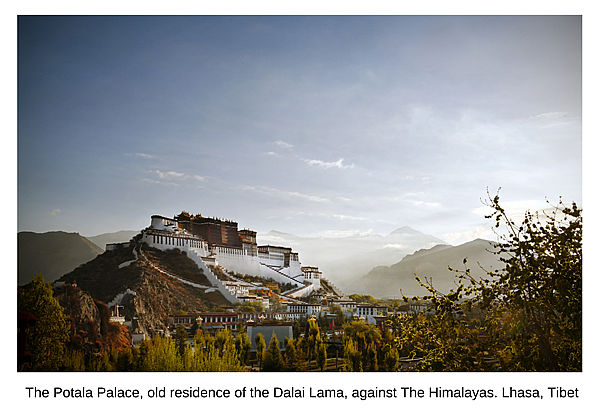 Tibet: The Rooftop of the World, A Spiritual Journey Unfolding
Tibet: The Rooftop of the World, A Spiritual Journey Unfolding
Envision yourself standing at the edge of an ethereal vista, the land itself rising to meet the sky, the air thin and crisp, resonating with whispered chants that carry stories of an ageless wisdom.
Welcome to Tibet, often referred to as the
'Rooftop of the World.' Nestled within the heart of the Himalayas, Tibet is a land that time forgot, a place where spirituality and nature intertwine in a symbiotic dance of harmony.
Tibet has a rugged and raw beauty that leaves one breathless, literally and metaphorically. The landscape is dominated by some of the highest mountains on Earth, including the colossal Mount Everest, whose peak punctures the sky with an unapologetic audacity. Tranquil lakes mirror the azure heavens, their surfaces occasionally ruffled by the wings of migratory birds. Wide open plateaus, the highest in the world, stretch out as far as the eye can see, the vast expanse broken only by the occasional flutter of prayer flags.
Yet, Tibet is not just about breathtaking natural beauty. It's also a spiritual haven, a place where the mundane meets the divine. This is a land where Buddhism permeates every aspect of life, where monasteries sit perched on hilltops like vigilant sentinels, their walls echoing with the rhythmic hum of monks in deep prayer.
The heart of this spiritual land is Lhasa, its capital, a city that fuses the old and new. Here, modern shops and restaurants nestle comfortably with ancient temples and monasteries. Dominating the city’s skyline is the magnificent Potala Palace, once the winter residence of the Dalai Lamas. It towers over Lhasa, an awe-inspiring architectural marvel of red and white, a testament to the human spirit's resilience and determination.
Life in Tibet has a rhythm of its own, dictated by ancient customs and rituals. Here, the people are the land's soul, their lives inextricably woven with their spiritual beliefs. Pilgrims undertake arduous journeys, prostrating themselves at every step, their bodies touching the earth in an unending cycle of devotion. Herders guide their yak and sheep across the expansive grasslands, their faces weathered by the harsh climate but softened by warm smiles.
Tibet invites you not merely to observe but to partake in a journey of discovery, to immerse yourself in its culture, its spiritual heritage, and its people. It's a journey that promises to be as enriching as it is enlightening.
For a short video introduction of Tibet, click below
Visa Requirements
Entering Tibet requires a Chinese Visa and a Tibet Travel Permit, which can only be obtained through a tour operator when you book a tour. Independent travel in Tibet is not allowed; all foreign tourists must be accompanied by a licensed tour guide.
Currency
The official currency of Tibet is the Chinese Yuan (RMB). Credit cards are accepted in larger establishments in Lhasa and Shigatse, but cash is essential in remote areas.
Language
The official language in Tibet is Tibetan, although Mandarin Chinese is widely spoken. English is not commonly understood outside of tourist areas.
Connectivity
Internet connectivity is available in major cities like Lhasa and Shigatse, but it can be patchy in remote areas. SIM cards can be purchased in larger cities, with China Mobile and China Unicom being the primary providers.
Health and Safety
Altitude sickness is a significant concern due to Tibet's high elevation. It's important to acclimatize and stay hydrated. Medical facilities are limited and travel insurance that covers emergency evacuation is highly recommended. Safety-wise, Tibet is generally safe for tourists, although you should take the usual precautions against pickpockets in crowded places.
Tourist Attractions Not To Be Missed
1. Potala Palace (Lhasa): Once the winter residence of the Dalai Lamas, Potala Palace is an architectural wonder, its towering structure a blend of palaces, chapels, and libraries. This UNESCO World Heritage site is a treasure trove of Tibetan Buddhist art, sculptures, and religious texts.
2. Jokhang Temple (Lhasa): Considered the spiritual heart of Tibetan Buddhism, the Jokhang Temple is a must-visit. Filled with richly decorated chapels dedicated to different deities and buddhas, the temple is often filled with devoted pilgrims, lending it a unique spiritual energy.
3. Mount Everest (Everest Base Camp): A trip to Tibet would be incomplete without witnessing the world's highest mountain, Mount Everest. The North Base Camp in Tibet offers jaw-dropping views of this natural wonder, a sight that leaves most speechless.
Last but not least
Here is another tip: Respect is key when visiting religious sites in Tibet. Remember to walk around temples and other sacred objects in a clockwise direction, and refrain from touching, smoking, or making loud noises. Also, don't photograph people without asking permission first. Abiding by these customs will ensure a more rewarding and respectful travel experience.
